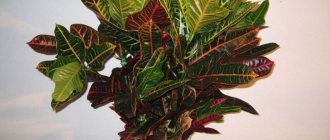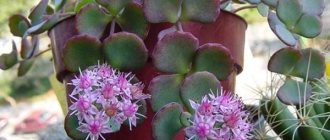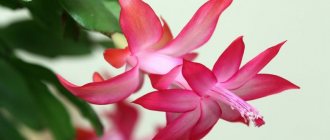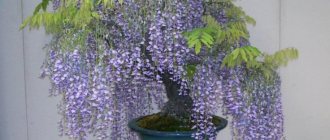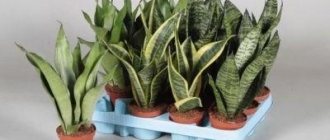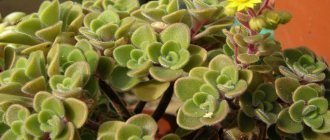The beautiful flowering plant Clivia is multi-flowered and belongs to the Amaryllis family. In the wild, this plant is widespread in the subtropical part of South Africa. In those regions where the climate is temperate, the flower is cultivated at home and in greenhouses. In such conditions, clivia has an average growth rate: up to six to eight leaf blades are formed during the year.
If the flower is well cared for, then its lifespan can be up to 40 years. During this time, from a small bush about 0.45 m high, the flower will turn into a large tub plant. The bush blooms in the last days of February. Over the course of 30 days, the plant exhibits alternate opening of spectacular bell-shaped flowers. The bush looks most impressive during flowering, but it does not lose its attractiveness the rest of the time. Its long and wide leaf blades grow in a thick fan and form a false stem.
general characteristics
Clivias are native to Africa, where they live in full or partial shade as subtropical forest plants. They can be found growing on rotting logs and other organic materials.
Although Clivias are slow growing, they eventually become quite large for a houseplant. They can take a decade to mature and fill a large container. The strong, dark green leaves curve beautifully over each other.
A photo of Clivia during the flowering period will help you convince yourself of the beauty of the spectacular flowers. The buds range in size from 2 to 7 cm. They bloom for about four weeks, since the weather is warm, flowering usually begins from February to April.
Flowering is followed by an active growing season when they need warmth, indirect sunlight and moderate watering. They appreciate feeding during growth.
After the warm season, Clivias require six to eight weeks of rest. Once warmer temperatures begin, you can begin regular maintenance and enjoy their flower show.
Types and varieties
We have already mentioned that only three types of clivia are grown in home floriculture.
Clivia gardenii
It grows in height up to half a meter, the leaves are long, belt-shaped, dark green, pointed at the ends. The peduncle is tall - up to 50 cm, the flowers are red bells, up to 15 pieces in an umbrella. Blooms in winter.
Clivia nobilis
The same belt-shaped or sword-shaped leaves up to forty centimeters in length, a high (up to half a meter) peduncle, long, funnel-shaped flowers, light red in color with green at the ends of the petals. There are from 30 to 60 flowers in an inflorescence. Flowering time is from late February to late spring.
Clivia miniata
The most common cultivated species is Clivia miniata, or Clivia cinnabar. Until it blooms, it is almost impossible to distinguish it from the beautiful clivia. Its leaves reach a length of 70 cm, are belt-shaped and dark green in color. The flowers of this species are red-orange, the bases of the petals are yellowish. Up to 20 flowers are formed on one peduncle. Blooms in spring. It was this species that became the basis for the development of new varieties of clivia.
Clivia variegated
These are varieties of Clivia cinnabar: the delicately colored "Japanese pastels" of a white-cream hue, the very popular cultivar "Striata" in Europe with bright orange flowers and leaves with yellow or white stripes, the variegated yellow variety "Solomon Yellow" or the snow-white "Snowball" and " Milk White”, delicate as a tea rose, white with pinkish tips of the petals “Mopi Heart”.
Light requirements
Clivias are naturally adapted to living in full or partial shade outdoors. They can survive in dimmer conditions, but they need good light to bloom.
Although these flowering plants require little care at home, direct sunlight will scorch them quickly, so proper lighting is important for good clivia care. “Tan” appears in the form of brown spots on foliage and spoiled flowers.
The north or east side of the house is generally ideal indoors, but they do well in any sunny location as long as they are protected from direct sunlight. Container plants are moved outside during the warmer months, but remember that they require shade.
Video
In the video you will find many useful care tips:
Clivia is very unusual and beautiful, it is difficult to confuse it with any other indoor flower. At the same time, it does not require particularly complex care, which makes it a real favorite of many gardeners.
Read about other indoor bulbous plants: spiral albuca, amaryllis, wallota, hemanthus, hyacinth, hippeastrum, gloriosa, drimiopsis, zephyranthes, Indian onion, calla, crinum, narcissus, nerine, oxalis, lily, scylla, freesia, eucharis. The catalog of all types is here.
How to water
Clivia loves evenly moist soil during the growing season, but does not tolerate waterlogging.
To know how to water a flower, make it a rule: let the top 50% of the soil dry before thoroughly soaking it. Outdoor plants can be watered by hand if the top few inches of soil are dry. As they mature, they become more drought tolerant.
The fleshy roots of Clivia rot easily in damp conditions. Also avoid getting water on the crown. Orange or pale green spots on the leaves may be a sign of overwatering.
When the Clivia plant goes dormant during the cooler months, reduce watering.
Soil requirements
Fast-draining soil is essential for good care of indoor Clivia flowers. Regular commercial soil is too heavy - you need an airy environment that will keep the roots from becoming waterlogged.
If you use peat moss, add aeration materials such as perlite or coarse sand. Consider your area: A little extra peat or other water-retaining material is fine for hot, dry areas, but not for cooler, wetter climates. Stay away from compact fine particles.
When the environment dries out quickly, it prefers organic material in its soil. Compost and leaf mold are excellent. They tolerate a wide pH range from 6.1 to 7.8 pH, but prefer mildly acidic. Note that bark or peat may acidify the soil as it decomposes.
Temperature Requirements
Clivia has a comfortable range of 16°C to 24°C throughout the growing season. They don't mind heat, but prefer cooler temperatures when cared for indoors.
Nap is the time when Clivia becomes more “choosy.” Without a rest period to reset the flowering cycle, the plant will remain evergreen but will not bloom the following year.
How to fertilize Clivia plants
Once your Clivia has flowered, they will do well when fed monthly with a ½ water soluble mixture or a 20-20-20 strength throughout the growing season. Both synthetic and organic fertilizers will work, but apply dry granules or powder away from the base of the plant to avoid nutrient toxicity.
Stop fertilizing completely when the weather turns cool in the fall and wait until the dormant period is over. When grown outdoors at home, they can be fed once every two months until the end of the growing season.
The only exception to these rules is fertilizing just after flowering begins: a moderate boost of ½ strength with a high potassium formula as the plant emerges from dormancy can produce good results. But don't overdo it.
After this early feeding, wait until flowering has finished before resuming normal fertilization during the warmer months.
Humidity
Clivia is one of the few tropical plants that do not require high humidity. They thrive in arid environments as long as temperatures remain within their preferred range. They never like a stuffy, heated room. If their leaves look limp, they can be moistened with a gentle sponge.
Bloom
Clivias rest after months of growth and will bloom the following season when they emerge from dormancy.
Flowering can occur any time from late winter to early summer. Older specimens tend to bud earlier, but timing may vary.
Choosing a selection method
The vegetative method is most often used. It does not require special conditions, long waiting times and can be part of an annual transplant. The young shoots being planted are already quite developed and will begin to bloom much earlier. But sometimes large adult specimens simply cannot be transplanted. Or the plant may simply not produce new shoots. Then you can resort to the second method.
The seed method is rarely used due to its low efficiency , but it allows you to propagate a plant that is difficult to transplant, and also opens up new horizons regarding selection on the windowsill. It is used mainly in the cold season.
No matter how interesting this method is, it cannot always be used. It should be used if the plant is more than 8 years old, it is healthy and receives enough nutrition. A large number of restrictions are justified by the fact that fruiting greatly depletes the plant.
We suggest reading other articles about clivia:
- Types of clivia and plant care.
- How to care for clivia at home?
Here's what to do before the flowering period
Move the houseplant to a well-lit area indoors before the first frost. Gradually reduce watering. In the plant's natural habitat, it rains during the warmer months - it waits to dry out during the cooler months.
Give the plant six to eight weeks of cool temperatures. The daytime temperature should be between 10-13°C and colder at night, but do not let it freeze.
After the rest cycle, move the plant to a warmer location with temperatures around 16-18°C and carefully begin regular watering. In a few weeks, budding should appear.
Rotate the container as the stem grows and the buds mature. Flowers seek light and bend strongly towards it.
Spent flowers develop into cherry-sized seed pods that slowly turn red or yellow over several months. The seeds will be fertile if they are pollinated. Some gardeners leave decorative berries; others prefer to trim the stem at the base to conserve plant energy - it's up to you.
Reproduction technology by dividing the bush
This method is applicable at the time of transplantation. In this case, the root system is divided into equal parts, and the cut areas are covered with a layer of charcoal. The plants are placed in pots filled with the correct soil mixture and not watered for the next three days. Then resume modest watering. The soil should dry out well between each watering.
Flowering of clivia, propagated by dividing the bush, will resume only after a few years.
Trimming
The only pruning that Clivia needs is to remove dying leaves and flowers. You may see ragged leaves after the dormant period, but maintenance is best done during the growing season after flowering has finished.
Trim the falling foliage at the base with sterile scissors. Flowering stems may remain for over a year while their pods develop, or may be removed after flowering.
Diseases, pests
More often, clivia can suffer from sunburn, which appears on the leaves as white spots. With overwatering and insufficient drainage, the tips of the plant turn brown and rust appears.
The plant is also susceptible to root rot and fungi (with abundant watering). Typically, these diseases appear after flowering, when the plant has weakened immunity.
As for pests, I like clivia leaves:
- whitefly - because of it, the plant sheds its leaves, and small white dots appear on them;
- mealybug - a fluffy white coating similar to cotton wool forms on the plant;
- spider mites - the leaves turn yellow, and if heavily infested, they fall off;
- aphids - manifests itself as sticky drops on leaves and buds;
- thrips - causes the appearance of yellow spots on the leaves and is noticeable on the underside of the leaves;
- scale insect - manifests itself as sticky drops on the leaves.
If a plant is damaged by pests, it is urgently necessary to treat it with special purchased products or folk methods.
How to propagate
There are several ways to propagate Clivias, including root division, offsets, and seeds.
The main problem with reproduction is their slow maturation. Offset plants grow faster, but still take several seasons to see flowers.
Here are the standard distribution methods:
Offsets - Allow shoots to grow to maturity. Just let them grow in the parent container until you are ready to transplant. Young shoots without roots can be planted in soil to grow them.
Root separation. Over time, the plant will outgrow the container and will need to be divided. It may be messy, but the roots are surprisingly resilient. Usually divided every three years. Divide the roots into groups so that each has leaves and several roots adjacent to it. Place in a well-drained mixture and care for them as usual.
Seeds – It’s not hard to grow from seeds, it’s just slow. Allow the pods to dry on the stem: this will take about eight months. When ready, remove the fleshy coating from the pods. Wear gloves to avoid skin irritation.
Place the growing medium in a warm place. The seeds rot easily, so press them into the mixture rather than bury them. Keep the soil moist but not wet.
When germination occurs, a thick root appears that can push the seeds out of the soil. Make a hole with a stick and replant so the seeds remain on a (slightly) damp surface. Give the seedlings bright light and transplant as soon as they have a few true leaves.
Planting Tips
Describing the flower, we can say that the plant is picky about drafts. Over-watering, over-fertilizing or over-potting can prevent flowering.
- Preserving the root system of Clivia helps them bloom better.
- Adjust watering frequency according to temperature. Allow the soil to dry more thoroughly in cooler conditions.
- If you place potted Clivias plants outside during the warmer months, place them under a shelter.
- Buying Clivias without flowers makes it difficult to determine their shade, but the color of the stem gives clues. Purple hues indicate that the plant has orange flowers. Specimens with yellow flowers usually have green stems.
Which soil to choose
A prerequisite for the normal growth of clivia is the presence of nutritious and loose soil. The flower naturally grows under trees, so it is accustomed to a large amount of humus in the soil.
An orchid substrate is ideal for home use. You can make a nutritious earthen mixture yourself by taking:
- 25% peat;
- 25% humus;
- 50% turf.
Important! This mixture needs to be enriched with a small amount of sand, which will help the soil become more breathable and not lose looseness.
The bottom of the pot is lined with a drainage layer. Any of the components will do the job perfectly for this purpose:
- expanded clay;
- crushed stone;
- broken brick;
- fine gravel.
All excess moisture that gets into the pot will accumulate in this layer without harming the roots. If you ignore the drainage layer, the liquid from watering will excessively wet the roots, which will lead to rotting and disease of the clivia.
The drainage can be sprinkled with calcium superphosphate granules. Such fertilizer will improve the growth of the green pet and promote the formation of buds and flowers.
Toxicity
Clivias contain lycorine, which is quite poisonous to dogs and cats; ingestion can cause weeks of diarrhea or even death. The seeds and berries are the most toxic.
Although the plant is not as dangerous to humans, you should still wear gloves when handling it to avoid skin and eye irritation.
Medicinal properties
The air in the room where clivia is kept is much cleaner and fresher. Beautiful inflorescences not only please the eye, but also calm the nervous system.
At the same time, the flower is very poisonous. If even a piece of the leaf gets inside the body, it will cause abdominal pain and vomiting.
The juice of the plant, if it gets on the skin, will lead to irritation, redness and itching. Under no circumstances should you smell a flower while touching your nose, as pollen, if it gets on the nasal mucosa, can cause paralysis or lead to loss of consciousness.


